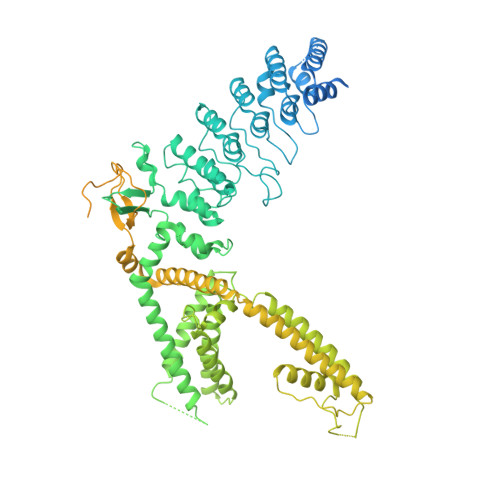Structural basis of TRPV3 inhibition by an antagonist.
Fan, J., Hu, L., Yue, Z., Liao, D., Guo, F., Ke, H., Jiang, D., Yang, Y., Lei, X.(2023) Nat Chem Biol 19: 81-90
- PubMed: 36302896
- DOI: https://doi.org/10.1038/s41589-022-01166-5
- Primary Citation of Related Structures:
7XJ0, 7XJ1, 7XJ2, 7XJ3 - PubMed Abstract:
The TRPV3 channel plays vital roles in skin physiology. Dysfunction of TRPV3 causes skin diseases, including Olmsted syndrome. However, the lack of potent and selective inhibitors impedes the validation of TRPV3 as a therapeutic target. In this study, we identified Trpvicin as a potent and subtype-selective inhibitor of TRPV3. Trpvicin exhibits pharmacological potential in the inhibition of itch and hair loss in mouse models. Cryogenic electron microscopy structures of TRPV3 and the pathogenic G573S mutant complexed with Trpvicin reveal detailed ligand-binding sites, suggesting that Trpvicin inhibits the TRPV3 channel by stabilizing it in a closed state. Our G573S mutant structures demonstrate that the mutation causes a dilated pore, generating constitutive opening activity. Trpvicin accesses additional binding sites inside the central cavity of the G573S mutant to remodel the channel symmetry and block the channel. Together, our results provide mechanistic insights into the inhibition of TRPV3 by Trpvicin and support TRPV3-related drug development.
- Beijing National Laboratory for Molecular Sciences, Key Laboratory of Bioorganic Chemistry and Molecular Engineering of Ministry of Education, Department of Chemical Biology, College of Chemistry and Molecular Engineering, Synthetic and Functional Biomolecules Center and Peking-Tsinghua Center for Life Sciences, Peking University, Beijing, China.
Organizational Affiliation:


















